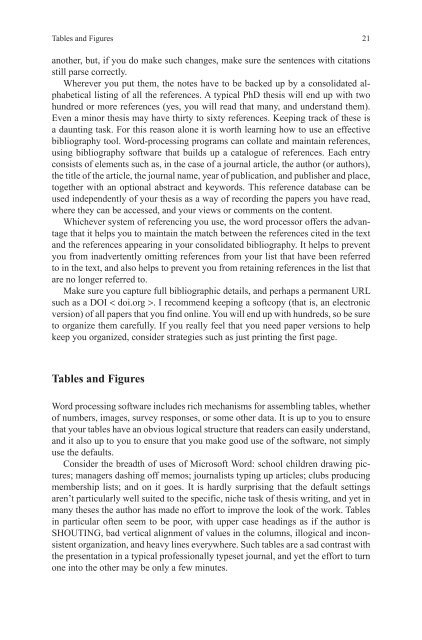How-to-Write-a-Better-Thesis
Create successful ePaper yourself
Turn your PDF publications into a flip-book with our unique Google optimized e-Paper software.
Tables and Figures <br />
21<br />
another, but, if you do make such changes, make sure the sentences with citations<br />
still parse correctly.<br />
Wherever you put them, the notes have <strong>to</strong> be backed up by a consolidated alphabetical<br />
listing of all the references. A typical PhD thesis will end up with two<br />
hundred or more references (yes, you will read that many, and understand them).<br />
Even a minor thesis may have thirty <strong>to</strong> sixty references. Keeping track of these is<br />
a daunting task. For this reason alone it is worth learning how <strong>to</strong> use an effective<br />
bibliography <strong>to</strong>ol. Word-processing programs can collate and maintain references,<br />
using bibliography software that builds up a catalogue of references. Each entry<br />
consists of elements such as, in the case of a journal article, the author (or authors),<br />
the title of the article, the journal name, year of publication, and publisher and place,<br />
<strong>to</strong>gether with an optional abstract and keywords. This reference database can be<br />
used independently of your thesis as a way of recording the papers you have read,<br />
where they can be accessed, and your views or comments on the content.<br />
Whichever system of referencing you use, the word processor offers the advantage<br />
that it helps you <strong>to</strong> maintain the match between the references cited in the text<br />
and the references appearing in your consolidated bibliography. It helps <strong>to</strong> prevent<br />
you from inadvertently omitting references from your list that have been referred<br />
<strong>to</strong> in the text, and also helps <strong>to</strong> prevent you from retaining references in the list that<br />
are no longer referred <strong>to</strong>.<br />
Make sure you capture full bibliographic details, and perhaps a permanent URL<br />
such as a DOI < doi.org >. I recommend keeping a softcopy (that is, an electronic<br />
version) of all papers that you find online. You will end up with hundreds, so be sure<br />
<strong>to</strong> organize them carefully. If you really feel that you need paper versions <strong>to</strong> help<br />
keep you organized, consider strategies such as just printing the first page.<br />
Tables and Figures<br />
Word processing software includes rich mechanisms for assembling tables, whether<br />
of numbers, images, survey responses, or some other data. It is up <strong>to</strong> you <strong>to</strong> ensure<br />
that your tables have an obvious logical structure that readers can easily understand,<br />
and it also up <strong>to</strong> you <strong>to</strong> ensure that you make good use of the software, not simply<br />
use the defaults.<br />
Consider the breadth of uses of Microsoft Word: school children drawing pictures;<br />
managers dashing off memos; journalists typing up articles; clubs producing<br />
membership lists; and on it goes. It is hardly surprising that the default settings<br />
aren’t particularly well suited <strong>to</strong> the specific, niche task of thesis writing, and yet in<br />
many theses the author has made no effort <strong>to</strong> improve the look of the work. Tables<br />
in particular often seem <strong>to</strong> be poor, with upper case headings as if the author is<br />
SHOUTING, bad vertical alignment of values in the columns, illogical and inconsistent<br />
organization, and heavy lines everywhere. Such tables are a sad contrast with<br />
the presentation in a typical professionally typeset journal, and yet the effort <strong>to</strong> turn<br />
one in<strong>to</strong> the other may be only a few minutes.














![[Lonely Planet] Sri Lanka](https://img.yumpu.com/59845622/1/169x260/lonely-planet-sri-lanka.jpg?quality=85)


